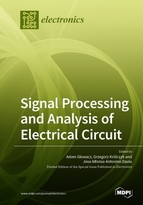Signal Processing and Analysis of Electrical Circuit
A special issue of Electronics (ISSN 2079-9292).
Deadline for manuscript submissions: closed (31 August 2019) | Viewed by 152092
Special Issue Editors
Interests: machine; fault diagnosis; pattern recognition; IoT; signal processing; signal analysis; image processing; computer science; automatic
Special Issues, Collections and Topics in MDPI journals
Interests: fault diagnosis; vibration analysis; measurement; materials
Special Issues, Collections and Topics in MDPI journals
Interests: electric motors; fault diagnosis; transient analysis; signal processing; wavelet analysis; infrared thermography; time-frequency transforms
Special Issues, Collections and Topics in MDPI journals
Special Issue Information
Dear Colleagues,
This Special Issue invites original research papers that report on the state-of-the-art and recent advancements in signal processing and analysis of electrical circuits. The analysis of electrical circuits is an essential task in the evaluation of these systems. Circuits are made up of interconnections of various elements such as resistors, inductors, transformers, capacitors, semiconductor diodes, transistors, and operational amplifiers. The electrical voltages, currents, and acoustic and vibrational signals that carry useful information are known as diagnostic signals. The extraction of information from a signal, the modification of a signal from one form to another, the separation of a signal from noise, spectrum analysers, image processers, etc., are also essential for telecommunications, instrumentation, control, and other applications. Prospective authors are invited to submit high-quality original contributions and reviews to this Special Issue. Potential topics include, but are not limited to:
- Signal processing and analysis methods of electrical circuits
- Electrical measurement technology
- Applications of signal processing of electrical equipment
- Fault diagnosis of electrical circuits
Prof. Dr. Adam Glowacz
Prof. Dr. Grzegorz Krolczyk
Prof. Dr. Jose Alfonso Antonino Daviu
Guest Editors
Manuscript Submission Information
Manuscripts should be submitted online at www.mdpi.com by registering and logging in to this website. Once you are registered, click here to go to the submission form. Manuscripts can be submitted until the deadline. All submissions that pass pre-check are peer-reviewed. Accepted papers will be published continuously in the journal (as soon as accepted) and will be listed together on the special issue website. Research articles, review articles as well as short communications are invited. For planned papers, a title and short abstract (about 100 words) can be sent to the Editorial Office for announcement on this website.
Submitted manuscripts should not have been published previously, nor be under consideration for publication elsewhere (except conference proceedings papers). All manuscripts are thoroughly refereed through a single-blind peer-review process. A guide for authors and other relevant information for submission of manuscripts is available on the Instructions for Authors page. Electronics is an international peer-reviewed open access semimonthly journal published by MDPI.
Please visit the Instructions for Authors page before submitting a manuscript. The Article Processing Charge (APC) for publication in this open access journal is 2400 CHF (Swiss Francs). Submitted papers should be well formatted and use good English. Authors may use MDPI's English editing service prior to publication or during author revisions.
Keywords
- • signal processing • signal analysis • electrical circuit • measurement • fault diagnosis








